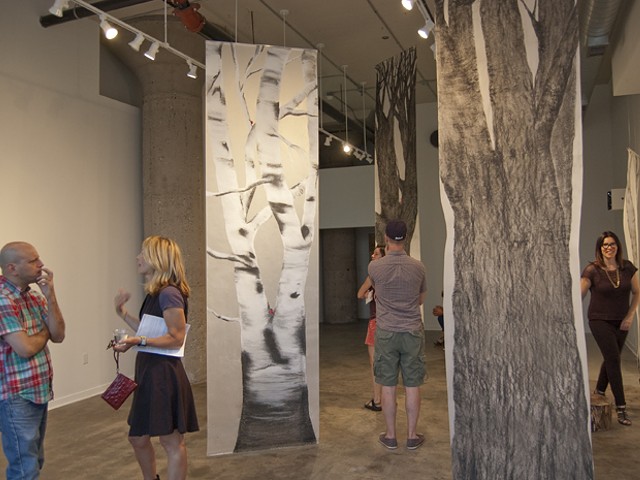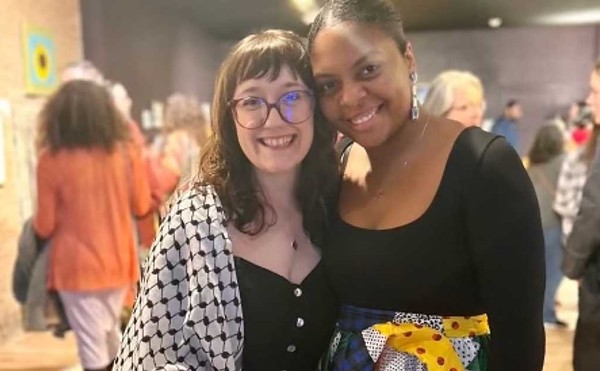Carl Lundgren’s rock ’n’ roll posters from the ’60s and ’70s have become synonymous with the groundbreaking music that defined the era. Designing dozens of posters for bills at the Grande Ballroom — for the likes of the MC5, Jefferson Airplane, the Who, and more — Lundgren’s colorful artwork perfectly encapsulates the psychedelic vibes of the music and the time, and have made him a sought-after and collectible artist. This was never his plan, though.
“It was just a fluke,” Lundgren says of his place in the annals of Detroit rock history. He originally wanted to move to New York and be a sci-fi and fantasy paperback cover artist. In the meantime, Lundgren needed money, and in his early 20s he crossed paths with Gary Grimshaw, who was already making a name for himself as a rock poster artist. Lundgren made some sample posters and showed them to Grimshaw, who dug them enough to let him take a crack at it, and the two began working together. “I was a fan of that stuff, and I just lucked into the fact that Detroit actually had a scene,” he says.
Lundgren explains that the old posters were made through a method of high-quality printing called lithography. “They were printed by a printer who actually printed menus for restaurants, so they were really high-quality, because the food has to look appetizing on menus,” he says. “The guy who ran the print shop was Gary’s uncle, and he hired these German printers with Heidelberg presses who came and printed all these beautiful posters. That’s why they’re so valuable and collectible.” That, and the fact that the posters were printed in limited editions.
The process was very labor-intensive, with the imagery painstakingly done by hand and then photographed. “I did a lot of work in the darkroom,” Lundgren says. “The photographs are transparent — they’re black and clear — and you had to manipulate the photos and put them through the process of making metal plates, that were eventually developed and then covered in ink.”
Lundgren notes how the restrictions of the medium shaped his style. “The more trips through the printing press, the more expensive the posters were to make,” he says. The promoters decided how many colors could be used, depending on the size of the concert. “I developed different processes where I could make two colors look like three, and three colors look like four,” he says. Lundgren found other ways to get around the cost as well. “Even on one color, [we] would make rainbows in the ink tray with different colored ink, so when they printed the poster it would have more than one color on it. I was kind of innovative. I was young and learning.”
Lundgren adds he was paid well for the posters at the time. “[Promoter and Grande Ballroom operator] Russ Gibb was very generous, even though the kids thought he was greedy because he charged $3.50 to see Pink Floyd and the Who,” he says. “Of course, compared to today’s prices, that’s laughable.”
Luck struck again — sort of — when Grimshaw was on the run from the law thanks to his involvement with the political leanings of the MC5, John Sinclair, and the White Panther Party, and Lundgren stepped in to run Grimshaw’s business for a few years. “He was on the run from the law. He had all kinds of problems. He was more into the politics and stuff — those guys were a little more politically inclined than I was,” Lundgren says. “I was just an artist and dug the music and the scene.”
He eventually was able to move to New York and pursue sci-fi and fantasy illustration for 13 years. In the ’80s, he quit doing commercial art and made a living doing fine art and selling prints at art fairs and Renaissance festivals around the country.
Thirty years later, Lundgren had all but forgotten about the rock posters. “People started asking me, ‘Where are your old posters?’” he says. “I didn’t have any, but I knew collectors that had kept them.” Lundgren started re-creating the posters, and made a career out of selling them throughout the ’90s and 2000s.
His most iconic poster is undeniably “Vanessa” — noted not for being for a historic gig but purely for its striking design. “It didn’t really have an important band — it was just for James Cotton Blues Band,” Lundgren says of the poster, which uses a photo of the actress Vanessa Redgrave. Lundgren says a “Vanessa” recently sold for $10,000 at an auction.
Fittingly, the image finds a home on the cover of a retrospective book that drops in the fall on Hermes Press. “They do mostly comic book stuff, but they love my posters,” Lundgren says. It is a worldwide reprint of a smaller “vanity edition” that Lundgren had self-published and sold out in two days.
Today Lundgren has re-created many of his old posters digitally, a process he calls “remastering.” “All of the mistakes that I made in the ’60s I can redo now and make perfect,” he says (though we have to admit his old lithographs retain an authentic charm that can’t be replicated or improved upon).
Last year he sold his rock poster business locally and has since retired, working on his own fine art oil paintings and collages. “I just do indoor gallery shows and museums — it’s so much easier than setting up a tent and sitting in the rain,” he says. “But I didn’t want to give up [the Wyandotte Street Art Fair], because I’ve been doing it for 27 years. It’s such a big thing for me, and they treat me really well there. I love doing that show.”
Lundgren says that large, limited-edition signed posters will be for sale. “I’ve been lucky,” Lundgren says. “I’ve been able to do what I’ve wanted to do my whole life. I’ve never really had a job, or had a bad day, or missed a meal. I’ve been able to make a good living at my art because I’ve wanted to. It’s work, but it’s work that I love, so it doesn’t really count. If you gave me a day off, I’d want to work on my art.”
The Wyandotte Street Art Fair is 10 a.m. to 9 p.m. daily, Wednesday, July 9 through Saturday, July 12. The fair is along Biddle Avenue, between Eureka and Oak streets in downtown Wyandotte. See wyandottestreetartfair.org for more information or call 734-324-4502.






